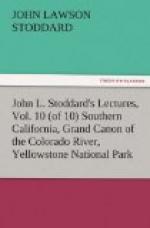[Illustration: ESTUFA AND SURROUNDINGS.]
[Illustration: MEXICAN OVENS.]
[Illustration: THE OLD CHURCH AT ACOMA.]
The only other notable structure in Acoma is the Roman Catholic church, the walls of which are sixty feet in height and ten feet thick. One can realize the enormous amount of labor involved in its construction, when he reflects that every stone and every piece of timber used in building it had to be brought hither on the backs of Indians, over the plains, from a considerable distance, and up the desperately difficult and narrow trail. Even the graveyard, which occupies a space in front of the church, about two hundred feet square, is said to have required a labor of forty years, since the cemetery had to be enclosed with stone walls, forty feet deep at one edge and filled with earth brought in small basket-loads up the steep ascent from the plain below. The church itself is regarded by the Indians with the utmost reverence, although it must be said that their religion is still almost as much Pagan as Christian. Thus, while they respect the priests who come to minister to them, they also have a lurking reverence for the medicine man, who is known as the cacique. He is really the religious head of the community, a kind of augur and prophet, who consults the gods and communicates to the people the answers he claims to have received. This dignitary is exempt from all work of a manual kind, such as farming, digging irrigation-ditches, and even hunting, and receives compensation for his services in the form of a tract of land which the community cultivates for him with more care than is bestowed




